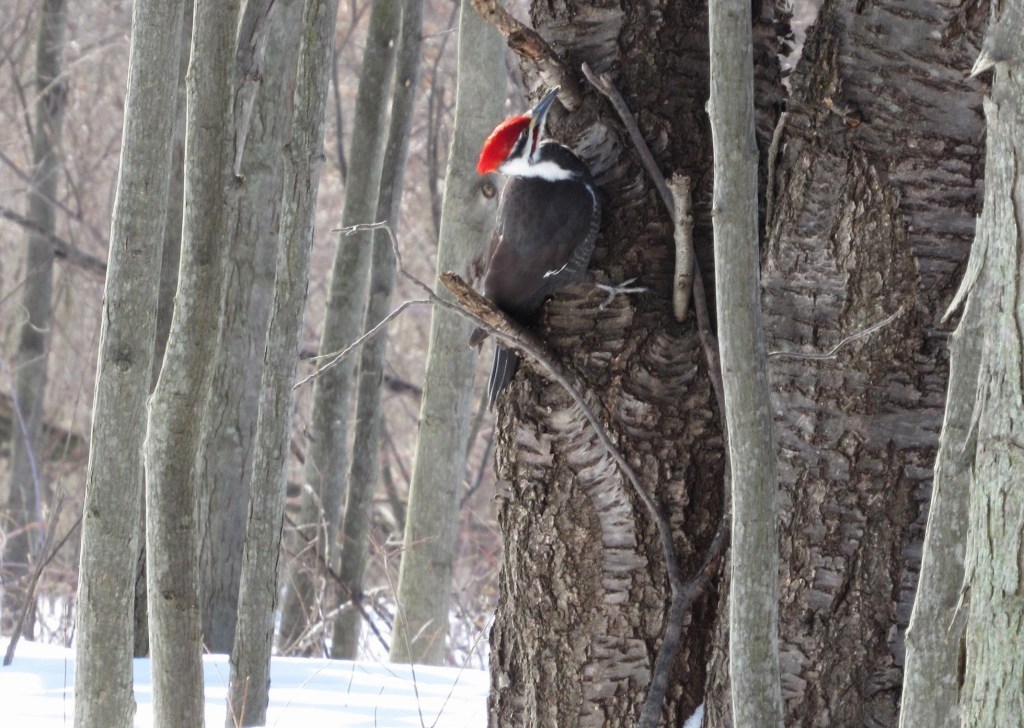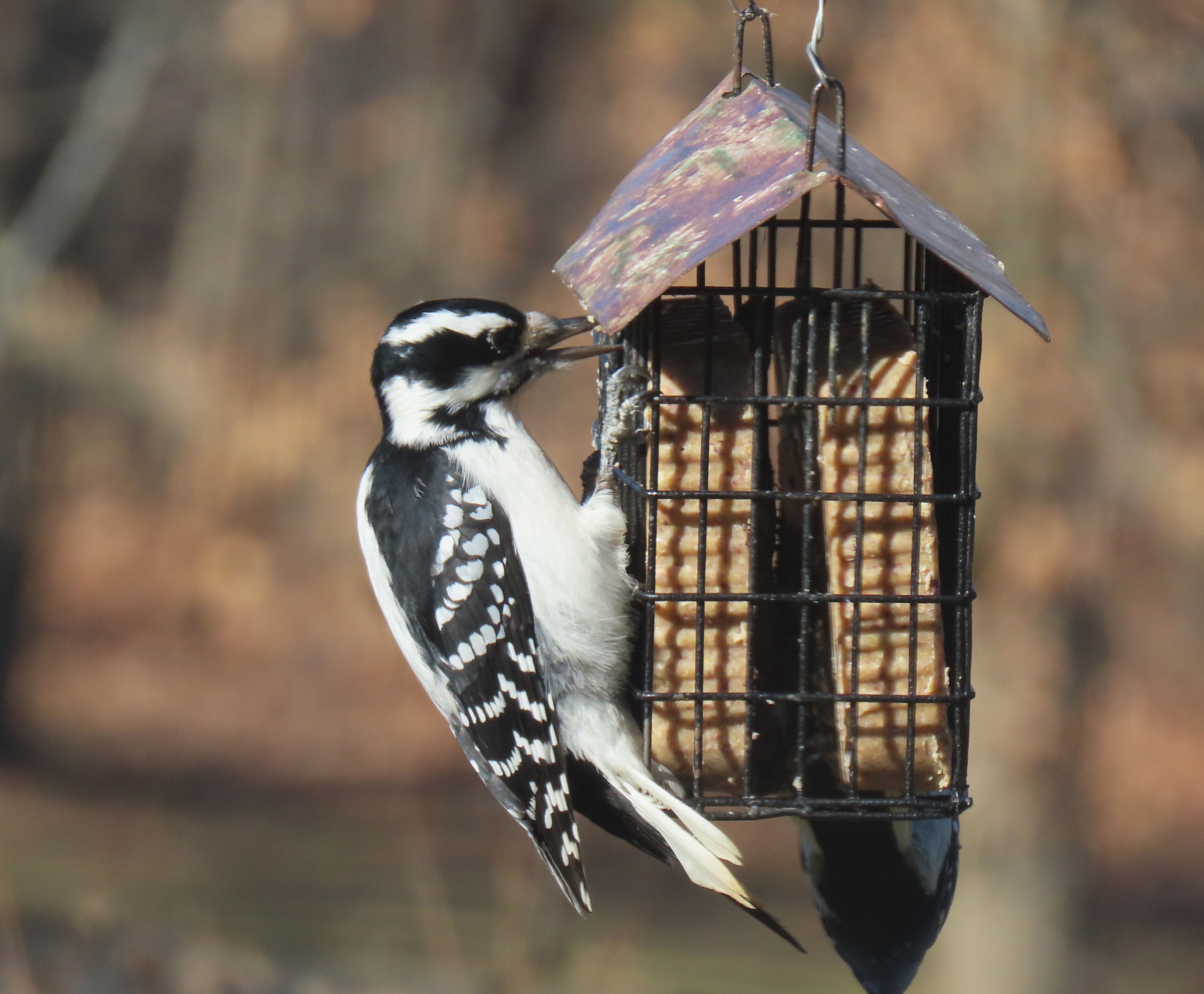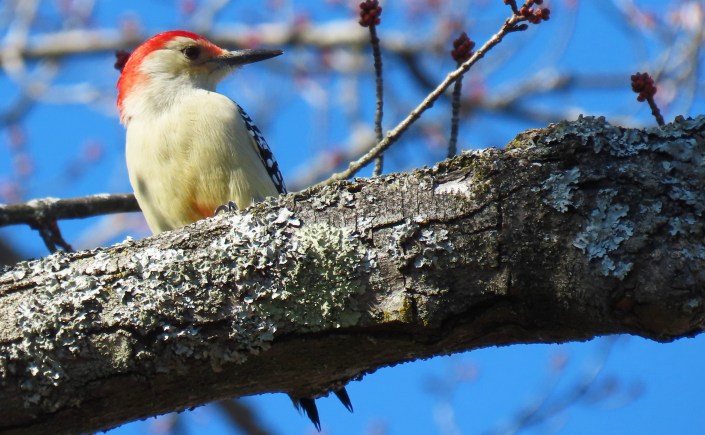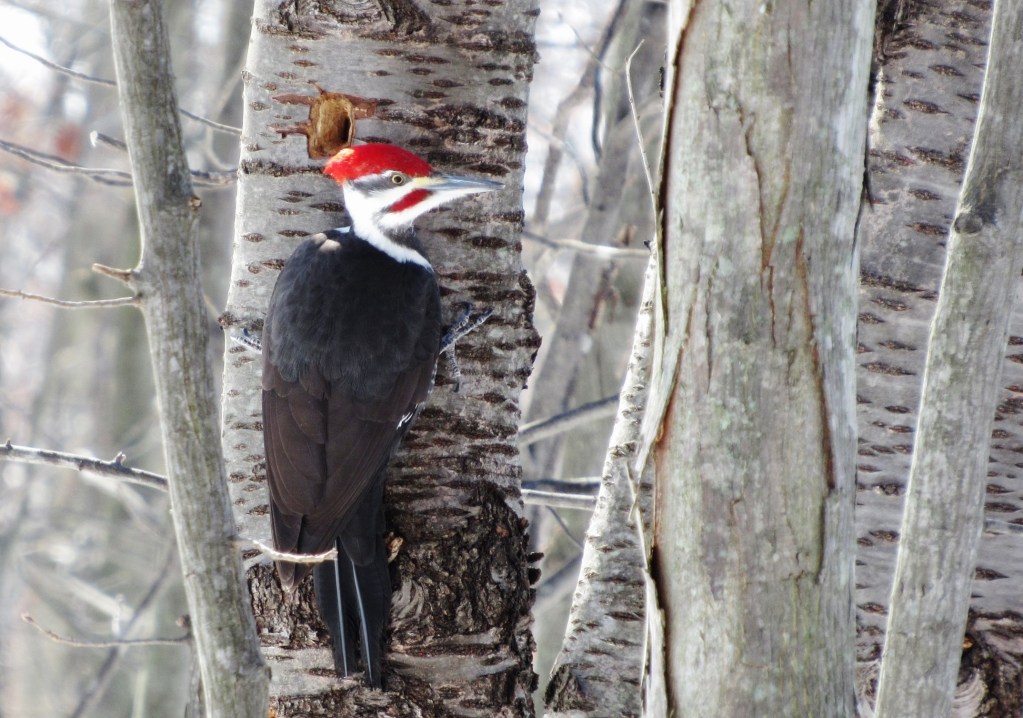WILDER SIDE OF OAKLAND COUNTY
It goes without saying that if you spend the day constantly hitting your forehead against a tree trunk, you will end up with a severe headache, at the very least. A concussion or brain injury may be more likely, but that’s not so for a woodpecker. Woodpeckers can spend all day pounding their heads against tree trunks at 20 times per second in search of hidden grubs and hibernating bugs and then come back for more pounding the next day. The activity is so fast that the human eye does not even notice that with each successful pounding, a woodpecker’s beak penetrates the bark, and its long sticky tongue zips in and out, snagging hidden insects and larvae.


Watching woodpeckers slam their powerful beaks against a tree trunk creates ear-catching sounds and eye-catching beauty, which has always attracted me to the wonderful world of woodpeckers. When winter arrives, that activity becomes even more noticeable for those that hike our woodlands or have dead trees near their homes. Even armchair birdwatchers can join in viewing avian head slamming if they tempt these amazing birds with the right treats and meet a few basic habitat needs. As for the headache from head thumping, unlike the human brain that would “bounce about” in the skull with even one severe blow, the finely evolved brain of a woodpecker is tightly confined and protected in place by muscles within its skull.

The Cornell Lab of Ornithology describes the head-thumping, insect-hunting technique of woodpeckers this way:
“Contrary to popular opinion, woodpeckers do not get headaches from banging on trees. They have thickened skulls and powerful neck muscles that enable them to deliver sharp blows without damaging their organs. Their stout, chisel-like bills allow them to bore into wood. The tongue of a woodpecker, often covered with barbs or sticky saliva, can be extended a considerable distance in order to dislodge ants and insect larvae from deep crevices in wood and bark. For storage, the tongue is curled around the back of the head between the skull and skin.”

If that information does not perk your interest enough to keep reading, how about this? Woodpeckers have what is known as a zygodactyl foot. You will never see a robin, crow, or house sparrow climb up a tree trunk. It’s not physically possible. The difference is in the configuration of their toes, and that’s also explained by the Cornell Lab of Ornithology:
“Most songbirds have three forward-facing toes and one backward-facing toe. Most woodpeckers, however, have two toes facing forward and one facing back. This is known as a zygodactyl foot and allows woodpeckers to easily climb and grasp trees and other structures. Woodpeckers move up a tree by hopping and depend on their especially stiff tail feathers to serve as a prop. They work their way up a tree, peering and poking into every nook and cranny, and then either fly in an undulating fashion to a new area or glide down to a neighboring tree to begin their foraging anew.”


I take pleasure in watching woodpeckers at my winter feeders and in the adjacent woods, taking note of how they spiral up trees in search of food. I’ve also photographed the cling and climb activity of Downy Woodpeckers scaling my lightning rod to access hidden insects under loose shingles. And when a woodpecker clings to a suet feeder, the curvature of the toes is easily noted.


Michigan is home to eight species of woodpeckers, with the Downy Woodpecker being the most commonly seen and perhaps, least feeder shy of all our woodpeckers. The other seven species are the Hairy Woodpecker, that looks pretty much like an oversized Downy; the Red-bellied Woodpecker; Pileated Woodpecker; Northern Flicker; Yellow-bellied Sapsucker; Red-headed Woodpecker; and the Black-backed Woodpecker, which is pretty much confined to our Upper Peninsula.



The woodpeckers most likely to be seen in Oakland County now are the Downy Woodpecker, Hairy Woodpecker, Red-bellied Woodpecker, and if you live in the northern part of the county or near a mature woodland elsewhere, the Pileated Woodpecker, a red-crested giant. Those are the four I highlight in this blog, starting with the very common Downy Woodpecker that is easily attracted to feeders by black oil sunflower seeds, suet, and peanuts.
Downy Woodpecker


The Downy Woodpecker is the most commonly seen species of woodpecker in Oakland County, and in most of Michigan, for that matter. It is also the smallest woodpecker in all of North America. They are often noticed in woodlands, exploring nooks and crannies or spiraling about a tree trunk. Their bills are often described as chisel-like, and they take on an obvious straight-backed posture when they lean away from tree trunks and use their stiff tail feathers for balance. Downy Woodpecker males have a bright red cap.


Although some say they are shy birds, I beg to differ and look at them as inquisitive and bold. They readily come to my bird feeding station when I am just a few feet away, replacing a block of suet. For some really close encounters, head to the trails of the Kensington Metropark Nature Center. If you stand perfectly still and offer sunflower seeds, they will land in your hand, a truly amazing experience.
Hairy Woodpecker

The Hairy Woodpecker is also very common and strikingly similar to the tiny Downy in general appearance, coloration, and feeder behavior. Novice birders sometimes think the much larger Hairy Woodpecker is the “parent” of the Downy. When seen from a distance, it’s hard to tell the two species apart, but when side by side, as in this image at a suet feeder, the size difference is obvious.

A careful observer will notice subtle differences, with the most obvious being a considerably longer, almost thorn-like bill on the Hairy Woodpecker. If you’re wondering if a woodpecker is a Hairy or Downy, this ID link from Audubon may help.
Pileated Woodpecker
The Pileated Woodpecker is the largest woodpecker of North America, and they have become increasingly common in Oakland County over the past two decades. I believe that’s because of the increased number of ash trees killed by the Emerald Ash Borer. Dead ash trees present an almost endless smorgasbord of grubs and hibernating insects. Pileated Woodpeckers are often seen in our heavily wooded parks and wildlands, but may also be found close to homes, visiting suet equipped bird feeders or dead trees if they are a short flight away. Those trees are perfect for them to chisel into and create large rectangular-shaped nesting holes. Both the male and female have a brilliant red crest, but the male also has a prominent red stripe on its cheek, as does this one in the woods, a few hundred feet from my house.
Red-bellied Woodpecker


Red-bellied Woodpeckers are one of the most beautiful woodpeckers of North America and are very much at home in Oakland County. However, the name red-bellied is a bit misleading. For in reality, they have just a slight blush of pale rose on their lower belly, which is often not visible unless it’s perched in such a fashion that its belly is exposed. These beauties are easily attracted to feeders, and I feel fortunate that they often perch on the limbs of my red maple tree, just a few dozen feet from my feeder station. Both the male and female have red napes, but the female lacks a red crown.


Attracting woodpeckers is easier than you might think, but it may take a few days or even a week or more until they discover your feeding station. The most straightforward way to attract woodpeckers of any species is to leave natural snags and nearby dead trees in place and provide the foods they love, which includes suet and sunflower seeds. If you place your feeder near an area of natural cover, it won’t be long until woodpeckers appear amidst snow flurries, adding near magical winged beauty to our soon to be wintery world. Or do what I did and position a window feeder that attaches with suction cups, and enjoy a really close-up show of Downy Woodpeckers. That show is often a pleasant distraction for me while I write and type.
Jonathan Schechter is the nature education writer for Oakland County Government and blogs weekly about nature’s way on the Wilder Side of Oakland County.
Follow along with Oakland County on Facebook, Instagram, LinkedIn, Pinterest, Twitter, and YouTube using #OaklandCounty, or visit our website for news and events year-round.




I am a Michigan and Florida birder. Love your photos and learn something be every time I read your blogs!
Thank you Linda. And I learn something new every time I put a blog together.